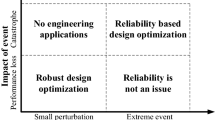Abstract
A generalized collaborative optimization (CO) framework is proposed to the optimization design of the lines of an underwater vehicle. The resistance and maneuvering performances are concerned about and taken as the optimization objectives in the optimization framework. The resistance, lateral force and yaw moment are calculated by RANS method. To improve the optimization efficiency, an automatic integration optimization platform is constructed in which a surrogate model is adopted. A SUBOFF model is taken as the verification model. The optimal results demonstrate the validity of the optimization strategy proposed.









Similar content being viewed by others
References
Cui WC, Ma L (2009) Hydrodynamic problems involved in submersible design. In: Proceedings of the 9th national congress on hydrodynamics and 22nd national conference on hydrodynamics, China
Hu K, Yu JC, Zhang QF (2005) Design and optimization of underwater glider shape. Robot 27(2):108–117
Cao AX, Zhao M, Liu W et al (2007) Application of multidisciplinary design optimization in the conceptual design of a submarine. J Ship Mech 11(3):373–382
Gou P, Cui WC (2010) Application of collaborative optimization in the structural system design of underwater vehicles. Ships Offshore Struct 5(2):115–123
Alam K, Ray T, Anavatti SG (2012) A new robust design optimization approach for unmanned underwater vehicle design. Proceed Inst Mech Eng Part M J Eng Mari Environ 226(3):235–249
Song L, Wang J, Yang ZY (2013) Research on shape optimization design of submersible based on Kriging model. J Ship Mech 17(1):8–13
Lyu WJ, Luo WL (2014) Design of underwater robot lines based on a hybrid automatic optimization strategy. J Mar Sci Appl 13(3):274–280
Luo WL, Lyu WJ (2015) An application of multidisciplinary design optimization to the hydrodynamic performances of underwater robots. Ocean Eng 104:686–697
Kroo I, Altus S, Braun R et al (1994) Multidisciplinary optimization methods for aircraft preliminary design. Proc AIAA NASA ISSMO Symp Multidiscip Anal Optim 4325:697–707
Han MH, Deng JT (2006) Improvement of collaborative optimization. Chin J Mech Eng 42(11):34–38
Braun R, Gage P, Kroo I et al (1996) Implementation and performance issues in collaborative optimization. AIAA-96-4017
Sobieski I, Kroo I (2000) Collaborative optimization using response surface estimation. AIAA J 38(10):1931–1938
Xiao M, Gao L, Shao XY et al (2012) A generalized collaborative optimization method and its combination with Kriging metamodels for engineering design. J Eng Des 23(5):379–399
Groves NC, Huang TT, Chang MS (1989) Geometric characteristics of DARPA SUBOFF models (DTRC Model Nos. 5470 and 5471). David Taylor Research Center
Phillips AB, Turnock SR, Furlong M (2010) Influence of turbulence closure models on the vertical flow field around a submarine body undergoing steady drift. J Mar Sci Technol 15(3):201–217
Roddy RF (1990) Investigation of the stability and control characteristics of several configurations of the DARPA SUBOFF model (DTRC Model 5470) from captive-model experiments. David Taylor Research Center
Zhang JT, Maxwell JA, Gerber AG, Holloway AG, Watt GD (2013) Simulation of the flow over axisymmetric submarine hulls in steady turning. Ocean Eng 1(57):180–196
Jin RC, Chen W, Sudjianto A (2003) An efficient algorithm for constructing optimal design of computer experiments. J Stat Plan Inference 134(1):268–287
Acknowledgments
The work of this paper was financially supported by the Program for New Century Excellent Talents in University of Fujian Province, China (Grant No. JA12015), and the Special Item for University in Fujian Province supported by the Education Department (Grant No. JK15003).
Author information
Authors and Affiliations
Corresponding author
About this article
Cite this article
Liu, K., Luo, W. Design of the lines of underwater vehicles based on collaborative optimization. J Mar Sci Technol 21, 709–714 (2016). https://doi.org/10.1007/s00773-016-0383-0
Received:
Accepted:
Published:
Issue Date:
DOI: https://doi.org/10.1007/s00773-016-0383-0



